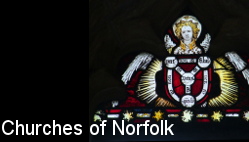
home I index I introductions I e-mail I about this site
St Michael, Oxnead
Follow these journeys as they happen at Last Of England Twitter.
| St
Michael, Oxnead The weather forecast promised a fine day ahead, and as it turned out it would be right. But for now, Norfolk huddled under a glowering, weeping sky as Cameron Self and I headed north from Norwich into the sticks. This area between Aylsham and North Walsham isn't particularly remote, but it seems so. Narrow lanes connect nowhere in particular with nowhere else, jinking along the former ends of strip-farmed fields, dipping under missing bridges from the time when Beeching and his colleagues stripped out the rural railway lines of Norfolk as if they were unwanted varicose veins. There are quiet little villages, the fields and copses typical of this area, and further off the beaten track memories of a quite different time in the not-so-distant past when this was an important place, as we will see. We turned down a farm track a couple of miles from the Cromer road, and there, set back in a high-hedged churchyard behind a screen of jackdaw-haunted trees, was Oxnead church. The first sight as you approach is a melancholy one, especially on a day like this, the ruined chapel on the north side of the chancel. You come round to the south side and the church unfolds as a small, plain building with a disproportionately narrow tower, and perhaps it is uncharacteristic for East Anglia, for although there is a 13th Century church at the heart of it, the repairs, embellishments and trimmings in red brick date from the 17th and early 18th Centuries, unusual dates for Norfolk. There is a good reason for this, and it can be seen by looking over the wall to the east of the church. There, you see all that remains of Oxnead Hall, one of the houses of the Paston family. Further, in the late 16th and early 17th Centuries it became, under the ownership of Sir Clement Paston, the greatest of all their houses. But little remains, for Sir Clement's heir Sir William Paston supported the wrong side in the English Civil War. Much of the estate was sequestered, and when he returned from exile after the Commonwealth Sir William was unable to return it to its former glories. By the 1670s the remainder of the estate was broken up and sold, and the Hall eventually descended into decay before most of it was demolished. What you see today is just the service wing, with the rebuilt modern Hall to the south of it. Turning back to the church, the raindrops dripping off the eaves under the gloomy sky, jackdaws wheeling and cawing around the churchyard trees, it was hard not think of it as a melancholy place. This was the Paston church at the height of the family's wealth and influence, but stepping inside, it is now hard to imagine the interior as it was in their day. There were several major restorations here during the 19th Century, and it has left a narrow interior with middlebrow furnishings and tiled floors. It has the character of dozens of other small country churches which were made fitting for worship during the second half of the 19th Century. However, there is one big difference, for this church is home to several memorials to the Oxnead Pastons dating from the late 16th and 17th Centuries. The most memorable of them is to Lady Katherine Paston who died in 1637. She was Sir William's first wife and mother of his heir, but she died shortly after giving birth to another child. Her bust stands under a pediment on a pedestal of black marble within an alcove of the same material, flanked by white marble tablets which carry the inscription and are topped by somewhat grumpy-looking cherubs. CB Newham, in his book Country Church Monuments, records that Sir William first employed the sculptor Nicholas Stone in 1631 to provide a series of statues, busts and other ornaments for Oxnead Hall. After the death of Lady Katherine, Stone was commissioned to create a monument to her. As he goes on to point out, the cherubs originally sat on top of the pedestal. There was a restoration of the memorials in the 1950s, so perhaps it happened then. The curiosity of this kind of
memorial is that it is pretty much wholly secular, and
although we nowadays associate churches, and particularly
churchyards, with 'remembering' the dead, this was still
a fairly new idea in the 17th Century. In a sense, these
early protestants invented the relationship with the dead
that we still articulate in churches today. Before the
Reformation, the dead played an active part in church
life, not only in the liturgy (they were praying for us,
while we prayed for them) but in the practical manner of
leaving bequests for memorials and church furnishings.
Their memorials focused the prayers of the parish on the
welfare of their souls after death. Such prayers for the
dead were anathema to protestants, and still are, but if
local landed families were still to press their
significance upon the ordinary people, what better way
than to continue to aggrandize themselves in the central
public building of the parish? Simon Knott, October 2022 Follow these journeys as they happen at Last Of England Twitter.
|
|
|||||||||||||||||||||||||||||||||||||||||||||||||||||||
home I index I latest I introductions I e-mail I about
this site I glossary
Norwich I ruined churches I desktop backgrounds I round tower churches
links I small
print I www.simonknott.co.uk I www.suffolkchurches.co.uk